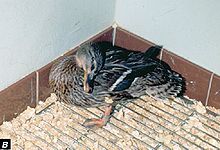Virulent Newcastle disease: Difference between revisions
rm unnecessary * |
No edit summary |
||
| Line 46: | Line 46: | ||
[[pt:Doença de Newcastle]] |
[[pt:Doença de Newcastle]] |
||
[[fi:Newcastlen tauti]] |
[[fi:Newcastlen tauti]] |
||
[[it:Malattia di Newcastle]] |
|||
Revision as of 08:58, 3 October 2007
Template:Taxobox begin Template:Taxobox begin placement virus Template:Taxobox group v entry Template:Taxobox ordo entry Template:Taxobox familia entry Template:Taxobox genus entry Template:Taxobox species entry Template:Taxobox end placement Template:Taxobox end

Newcastle disease is a highly contagious zoonotic bird disease affecting many domestic and wild avian species. Its effects are most notable in domestic poultry due to their high susceptibility and the potential for severe impacts of an epidemic on the poultry industries. It is endemic to many countries.
Newcastle Disease was discovered in the East Indies in 1926, but it is named after Newcastle-upon-Tyne, England, where it was rediscovered a year later by in 1927.
The causal agent, Newcastle disease virus (NDV), is a negative-sense single-stranded RNA virus. Transmission occurs by exposure to faecal and other excretions from infected birds, and through contact with contaminated feed, water, equipment and clothing.
Exposure of humans to infected birds (for example in poultry processing plants) can cause mild conjunctivitis and influenza-like symptoms, but NDV otherwise poses no hazard to human health. Interest in the use of NDV as an anticancer agent has arisen from the ability of NDV to selectively kill human tumour cells with limited toxicity to normal cells.
Signs of infection with NDV vary greatly depending on factors such as the strain of virus and the health, age and species of the host. They can include respiratory signs (gasping, coughing), nervous signs (depression, inappetence, drooping wings, paralysis), swelling of the eyes and neck, diarrhoea, misshapen, rough- or thin-shelled eggs and reduced egg production.
NDV strains can be categorised as velogenic (highly virulent), mesogenic (intermediate virulence) or lentogenic (nonvirulent). Velogenic strains produce severe nervous and respiratory signs, spread rapidly and cause up to 90% mortality. Mesogenic strains cause coughing, affect egg quality and production and result in up to 10% mortality. Lentogenic strains produce mild signs with negligible mortality.
No treatment for NDV exists, but the use of prophylactic vaccines and sanitary measures reduces the likelihood of outbreaks.
Newcastle disease variant
In 2006 researchers from the Hebrew University have succeeded in isolating a variant of the Newcastle Disease Virus (NDV-HUJ), in order to specifically target cancer cells [1]. NDV-HUJ is a natural variant of NDV Virus and is also an attenuated variant (e.g., weakened virus), it innately preferentially targets and replicates in certain types of tumor cells (brain and lung), leaving normal cells almost unaffected. The researchers tested the new Viro-therapy on 14 Glioblastoma multiforme patients and achieved promising results for the first time.
References
- Nelson CB, Pomeroy BS, Schrall K, Park WE, Lindeman RJ. (1952). An outbreak of conjunctivitis due to Newcastle disease virus (NDV) occurring in poultry workers. Am J Public Health 42(6):672–8.
